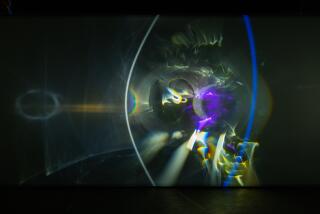SWITCHING ROLES IN ‘TOUCH AND GO’
- Share via
The Fine Arts Gallery at Cal State Los Angeles is nearly vacant. There are only switches, that bring forth non-musical sounds from little black boxes.
These are the minimal components of “Touch and Go,” the latest “sound sculpture” by Michael Brewster, who has designed and executed similar installations locally, in other parts of the United States and throughout Europe during the last decade. And like earlier projects, this one “performs” a simple series of operations but creates a complex relationship between viewer and exhibition space.
His title for the show tells us what to expect, on both rudimentary and deeper psychological levels. The word touch is flickering on a first light switch. But as soon as one presses it, touch dims, go lights up and a sound beckons us down a hallway and around the corner to the first gallery room. Combining the use of a switch and the lure of the sound--which resembles a muted horn fading and crescendoing over and over--he manages to direct the viewer to a specific destination.
But it is there that the dilemma begins. Should the visitor go any further, or has he already arrived?
The next room--if the viewer peeks prematurely around the corner--is silent and dim while the first black box is producing its sound effects, accompanied by red and white lights; so I was inclined to stay in the first room until the piece informed me otherwise. Sure enough, after a few minutes the sounds from this box faded, the light switch in the first chamber said touch and, once pressed, activated lights and sound in the second one (this time, a more sharply rising and falling horn-like sound). Once that room grew quiet and dark, it was evident that the time had come to leave, or to begin the process again.
It becomes clear, however, that the purpose of the piece isn’t simply to perform for us. Rather, the visitor is the subject of Brewster’s installation as much as it is an object for his contemplation. As the artist writes in an accompanying brochure, “The user behaves sculpturally, probing the field as a ‘moving viewer.’ ” In other words, one’s experience of the piece depends on a decision to stand in one place, keeping the sound and light relatively consistent, or to move around, which alters the effect of both.
For me, the piece had larger experiential effects as well. With little to see, a viewer’s perceptions are thrown back at him. (In this respect, Brewster’s work has affinities with the more spare “light and space” installations, such as Maria Nordman’s.) I became acutely conscious of time passing and of my own position within the confines of the gallery space. And upon departing, I had no doubts that I had indeed traveled somewhere worthwhile, even if I hadn’t actually gone anywhere except through a couple of gallery rooms.
The exhibition continues to Feb. 18. Gallery hours are Monday-Friday, noon to 5 p.m.
More to Read
The biggest entertainment stories
Get our big stories about Hollywood, film, television, music, arts, culture and more right in your inbox as soon as they publish.
You may occasionally receive promotional content from the Los Angeles Times.










